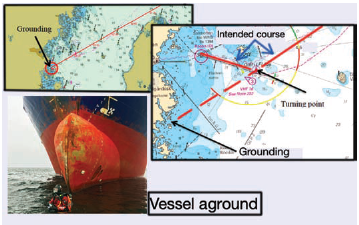202028 More fatigue, another grounding
A small vessel was on a short sea trading routine, making shuttle trips between two ports separated by approximately 12 hours sailing. On the ballast leg of the route, the Master had taken the night watch to allow the chief mate to rest, as he would be busy all the next day with cargo operations once in port. There was no lookout on the bridge during any part of the voyage because, according to the Master, the crew had worked so hard during the unloading period.
At one point the Master altered course toward the destination port. The next thing he remembered, he was woken by a call on the VHF radio. The call came from the pilot boat at the arrival port, asking if everything was OK because the vessel seemed to be in shallow water.
The Master answered that everything was fine – but within a few seconds of the call, the vessel grounded. The vessel had passed straight by the arrival destination without turning to port and had continued on until it grounded.

The official investigation noted, among others, that:
- The BNWAS was not turned on; The Master was probably fatigued himself due to the two watch system;
- The Master was probably under the influence of alcohol during his watch;
- There was no lookout on the bridge during the transit.
Lessons learned
- A ‘dry’ ship is a safer ship. Alcohol and ship work do not mix well;
- As in MARS 202027, a BNWAS can be a helpful tool to help prevent sleep related accidents;
- As in MARS 202027, being alone on the bridge at night is not best practice;
- Even though this vessel was manned according to its safe manning certificate, it was evidently understaffed for the job it was required to do in the time that was expected. So, why did the Master leave port if everyone was fatigued?
